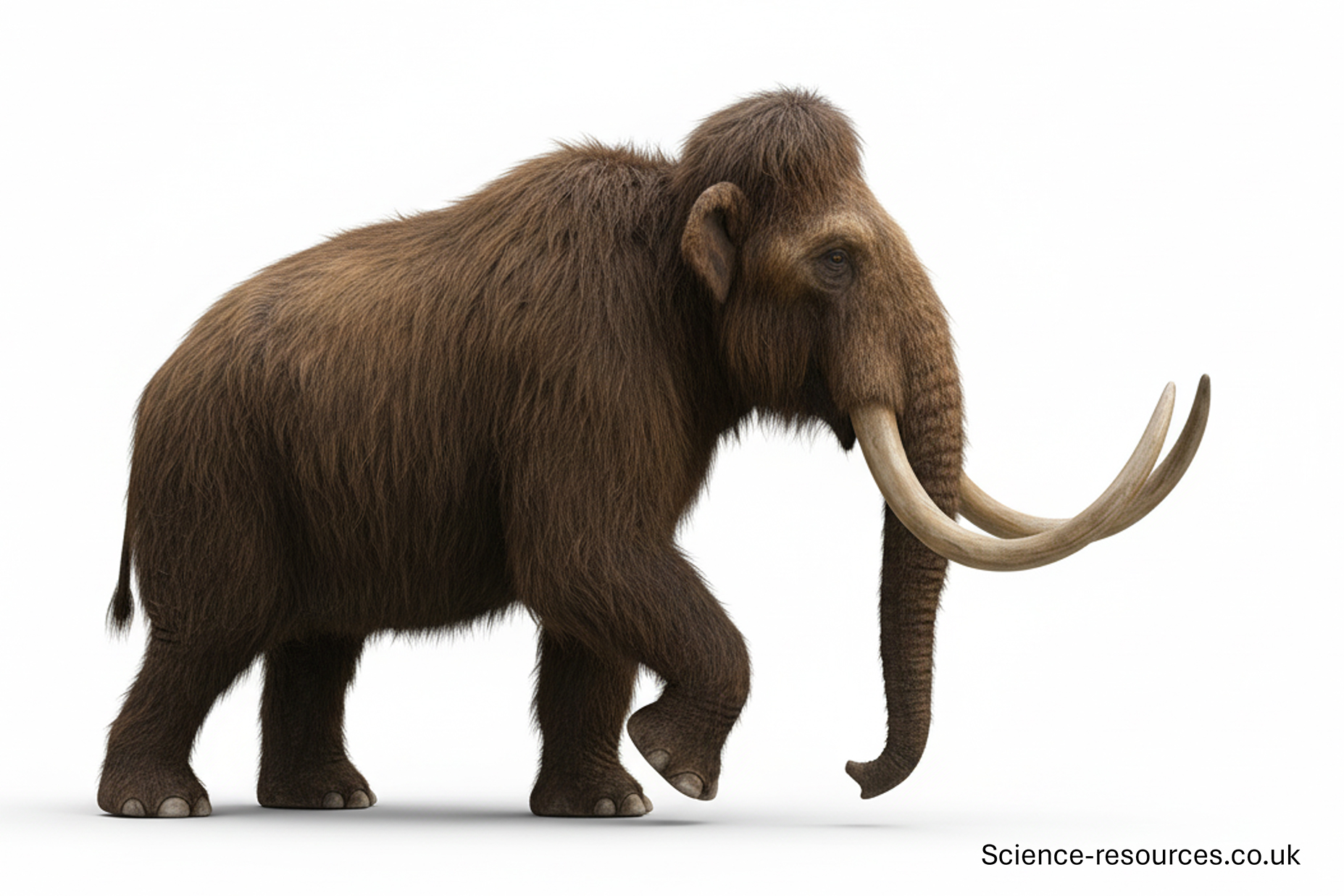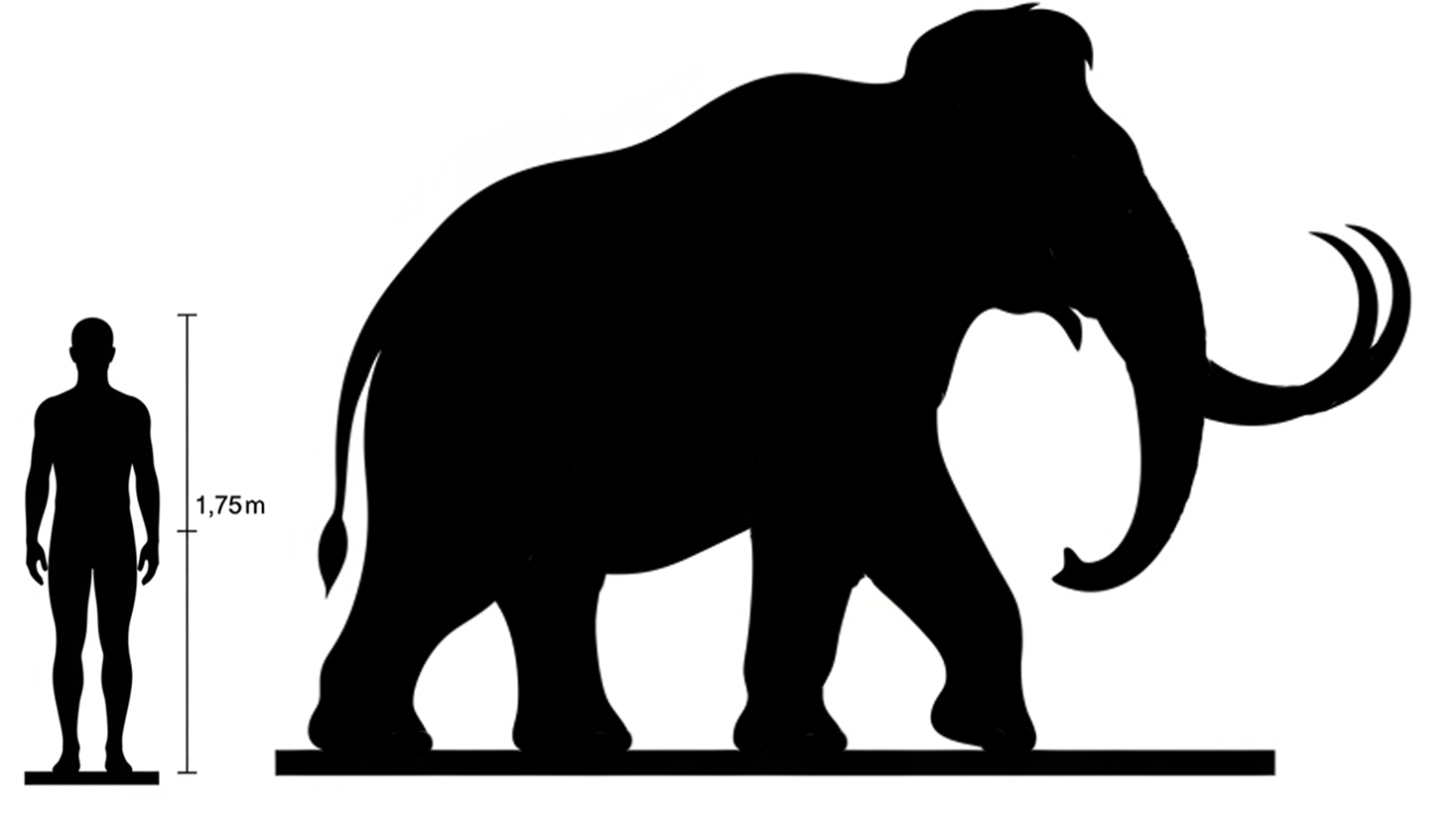Last updated: 4th August 2025
Extinct Animals: Woolly Mammoth
Woolly Mammoth, a giant, shaggy elephant with long, curved tusks, that lived during the Pleistocene.
Woolly Mammoth (Mammuthus Primigenius)
 Woolly Mammoth
Woolly Mammoth
Generative AI Notification: Some elements of this image have been created or enhanced using AI technology. To find out how we create all our prehistoric animals, click here.
What is a Woolly Mammoth?
The Wooly Mammoth was a species of mammoth that lived during the Pleistocene epoch, one of the last in its lineage.
How big were Woolly Mammoths?
Similar in size to a modern African elephant, males could reach a shoulder height of 3.4 meters.
What did Woolly Mammoths eat?
They were herbivores, primarily grazing on grasses and sedges. They used their tusks to clear snow and forage.
Woolly Mammoth appearance
They were covered in a thick layer of brown hair, with a fatty hump on their back for energy storage, and long, curved tusks.
 Woolly mammoth appearance
Woolly mammoth appearance
Where did Woolly Mammoths live?
Fossils and frozen carcasses have been found in North America and Eurasia.
Interesting facts
The discovery of well-preserved frozen mammoths has allowed scientists to study their DNA and even consider de-extinction efforts.

Woolly Mammoth Facts
Pronounced: WOOL-ee MAM-uhth
Name Means: "Earth Burrower" (from Russian mamont)
Length: Up to 4 meters (13 feet)
Height: Around 3.5 meters (11.5 feet) at the shoulder
Weight: Up to 6,000 kilograms (13,200 pounds)
Diet: Herbivore (Grasses, shrubs, and other tundra vegetation)
Time: Late Pleistocene Epoch (about 400,000 to 4,000 years ago)
Fossils Found: Europe, Asia, and North America (especially Siberia and Alaska)
Which family of animals did Woolly Mammoths belong to?
They were part of the family Elephantidae, making them close relatives of modern elephants.
 Woolly mammoth size comparison
Woolly mammoth size comparison
What other animals lived at the same time as Woolly Mammoths?
They lived alongside wooly rhinos, giant ground sloths (Megatherium), and early human populations, who often hunted them for food and resources.
Woolly Mammoth FAQ
Q1: What is a Woolly Mammoths?
A1: The Woolly Mammoth (Mammuthus primigenius) was a large, extinct species of elephant that lived during the Ice Age. It was well-adapted to cold environments and is one of the most iconic prehistoric animals.
Q2: When did Woolly Mammoths live?
A2: Woolly Mammoths lived from around 400,000 years ago until about 4,000 years ago, with the last known population surviving on Wrangel Island in the Arctic Ocean.
Q3: What did Woolly Mammoths look like?
A3: They had long, shaggy hair, a thick layer of fat for insulation, small ears to reduce heat loss, and long, curved tusks. They were similar in size to modern African elephants.
Q4: Where did Woolly Mammoths live?
A4: They roamed across the mammoth steppe—a vast, cold, dry grassland that stretched from Western Europe through northern Asia and into North America.
Q5: What did Woolly Mammoths eat?
A5: They were herbivores, feeding mainly on grasses, shrubs, and other tundra vegetation. Their large molars were adapted for grinding tough plant material.
Q6: How big were Woolly Mammoths?
A6: Adult males stood about 3 to 3.5 meters (10 to 11.5 feet) tall at the shoulder and weighed up to 6 tons. Females were slightly smaller.
Q7: Why did Woolly Mammoths go extinct?
A7: Their extinction was likely caused by a combination of climate change, habitat loss, and overhunting by humans. Isolated populations survived longer in remote areas.
Q8: Are Woolly Mammoths related to modern elephants?
A8: Yes, they are closely related to the Asian elephant (Elephas maximus), sharing a common ancestor around 6 million years ago.
Q9: Have any Woolly Mammoth remains been found?
A9: Yes, thousands of remains have been found, including well-preserved frozen carcasses in Siberia with skin, hair, and even stomach contents intact.
Q10: Can Woolly Mammoths be brought back to life?
A10: Scientists are exploring de-extinction through cloning or genetic engineering using mammoth DNA, but ethical, ecological, and technical challenges remain significant.
You may also be intrested in:
- Extinct Animals: A-Z
- Dinosaurs: A-Z
Tags: How big was Woolly Mammoth, Woolly Mammoth size, where did Woolly Mammoth live, how tall was Woolly Mammoth, what does Woolly Mammoth mean, Woolly Mammoth facts
Previous: Smilodon
Up next: Woolly Rhino
© 2012 science-resources.co.uk. All rights reserved | Design by W3layouts
Extinct Animals: Woolly Mammoth
Woolly Mammoth, a giant, shaggy elephant with long, curved tusks, that lived during the Pleistocene.
Woolly Mammoth (Mammuthus Primigenius)
 Woolly Mammoth
Woolly Mammoth
Generative AI Notification: Some elements of this image have been created or enhanced using AI technology. To find out how we create all our prehistoric animals, click here.
What is a Woolly Mammoth?
The Wooly Mammoth was a species of mammoth that lived during the Pleistocene epoch, one of the last in its lineage.
How big were Woolly Mammoths?
Similar in size to a modern African elephant, males could reach a shoulder height of 3.4 meters.
What did Woolly Mammoths eat?
They were herbivores, primarily grazing on grasses and sedges. They used their tusks to clear snow and forage.
Woolly Mammoth appearance
They were covered in a thick layer of brown hair, with a fatty hump on their back for energy storage, and long, curved tusks.
 Woolly mammoth appearance
Woolly mammoth appearance
Where did Woolly Mammoths live?
Fossils and frozen carcasses have been found in North America and Eurasia.
Interesting facts
The discovery of well-preserved frozen mammoths has allowed scientists to study their DNA and even consider de-extinction efforts.

Woolly Mammoth Facts
Pronounced: WOOL-ee MAM-uhth
Name Means: "Earth Burrower" (from Russian mamont)
Length: Up to 4 meters (13 feet)
Height: Around 3.5 meters (11.5 feet) at the shoulder
Weight: Up to 6,000 kilograms (13,200 pounds)
Diet: Herbivore (Grasses, shrubs, and other tundra vegetation)
Time: Late Pleistocene Epoch (about 400,000 to 4,000 years ago)
Fossils Found: Europe, Asia, and North America (especially Siberia and Alaska)
Which family of animals did Woolly Mammoths belong to?
They were part of the family Elephantidae, making them close relatives of modern elephants.
 Woolly mammoth size comparison
Woolly mammoth size comparison
What other animals lived at the same time as Woolly Mammoths?
They lived alongside wooly rhinos, giant ground sloths (Megatherium), and early human populations, who often hunted them for food and resources.
Woolly Mammoth FAQ
Q1: What is a Woolly Mammoths?
A1: The Woolly Mammoth (Mammuthus primigenius) was a large, extinct species of elephant that lived during the Ice Age. It was well-adapted to cold environments and is one of the most iconic prehistoric animals.
Q2: When did Woolly Mammoths live?
A2: Woolly Mammoths lived from around 400,000 years ago until about 4,000 years ago, with the last known population surviving on Wrangel Island in the Arctic Ocean.
Q3: What did Woolly Mammoths look like?
A3: They had long, shaggy hair, a thick layer of fat for insulation, small ears to reduce heat loss, and long, curved tusks. They were similar in size to modern African elephants.
Q4: Where did Woolly Mammoths live?
A4: They roamed across the mammoth steppe—a vast, cold, dry grassland that stretched from Western Europe through northern Asia and into North America.
Q5: What did Woolly Mammoths eat?
A5: They were herbivores, feeding mainly on grasses, shrubs, and other tundra vegetation. Their large molars were adapted for grinding tough plant material.
Q6: How big were Woolly Mammoths?
A6: Adult males stood about 3 to 3.5 meters (10 to 11.5 feet) tall at the shoulder and weighed up to 6 tons. Females were slightly smaller.
Q7: Why did Woolly Mammoths go extinct?
A7: Their extinction was likely caused by a combination of climate change, habitat loss, and overhunting by humans. Isolated populations survived longer in remote areas.
Q8: Are Woolly Mammoths related to modern elephants?
A8: Yes, they are closely related to the Asian elephant (Elephas maximus), sharing a common ancestor around 6 million years ago.
Q9: Have any Woolly Mammoth remains been found?
A9: Yes, thousands of remains have been found, including well-preserved frozen carcasses in Siberia with skin, hair, and even stomach contents intact.
Q10: Can Woolly Mammoths be brought back to life?
A10: Scientists are exploring de-extinction through cloning or genetic engineering using mammoth DNA, but ethical, ecological, and technical challenges remain significant.
Tags: How big was Woolly Mammoth, Woolly Mammoth size, where did Woolly Mammoth live, how tall was Woolly Mammoth, what does Woolly Mammoth mean, Woolly Mammoth facts
Previous: Smilodon
Up next: Woolly Rhino
© 2012 science-resources.co.uk. All rights reserved | Design by W3layouts